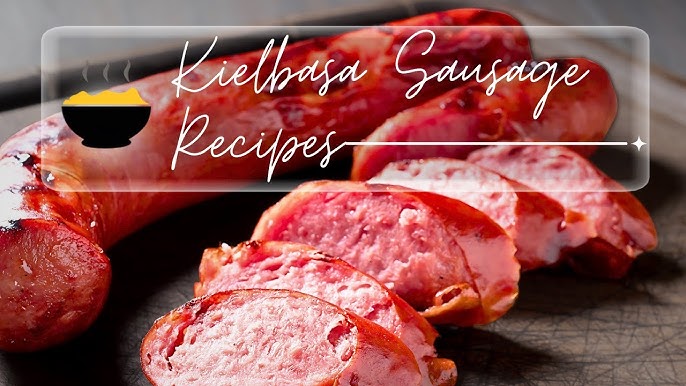Kielbasa Recipe: Kielbasa is the Polish word for “sausage,” but it’s not just any sausage — it’s a flavorful, juicy, and often smoky delicacy.
Traditionally made from pork and seasoned with garlic, marjoram, and black pepper, kielbasa is a staple in many Eastern European households.
Whether grilled, baked, smoked, or simmered, its hearty, rich flavor makes it the centerpiece of countless meals.
A Brief History of Kielbasa
Kielbasa dates back to the 14th century in Poland. Originally, it was a simple way to preserve meat, especially during harsh winters when refrigeration was impossible. Over time, each region developed its own version, using local spices and smoking techniques. Today, kielbasa is enjoyed worldwide and features many varieties — from the smoky, garlicky Polish Wiejska to the spicy Krakowska.
Ingredients You’ll Need
Main Ingredients
Here’s what you need to make traditional kielbasa:
- 3 pounds pork shoulder (with some fat)
- 1 pound beef (optional for a richer flavor)
- 4 cloves garlic, minced
- 1 tablespoon salt
- 1 teaspoon black pepper
- 1 teaspoon marjoram
- 1/2 cup cold water
- Natural hog casings (rinsed and soaked)
These basic ingredients create the classic kielbasa flavor — bold, juicy, and slightly smoky.
Optional Add-Ins for Extra Flavor
Want to jazz up your kielbasa? Consider these extras:
- Red pepper flakes for heat
- Smoked paprika for extra smokiness
- Caraway seeds for a traditional touch
- A splash of white wine for depth
Adding just a couple of these options can personalize your kielbasa to your own taste preferences.
Tools and Equipment
Kitchen Essentials for Making Kielbasa
You don’t need a fancy kitchen setup, but having the right tools will make your sausage-making process smooth:
- Meat grinder (manual or electric)
- Sausage stuffer or sausage attachment for your grinder
- Large mixing bowls
- Sharp knife
- Clean kitchen towels
- Smoker (optional if you want smoked kielbasa)
Investing in quality equipment, especially a good meat grinder and stuffer, will pay off if you plan to make kielbasa regularly.
Preparing the Meat
Choosing the Right Meat
The key to delicious kielbasa is using the right meat blend. Pork shoulder is perfect because it has the ideal ratio of fat to meat (about 80/20). Some people like to mix in a bit of beef for a deeper flavor, but you can stick with all pork if you prefer a traditional taste.
Make sure to keep everything very cold — the meat, the grinder parts, and even the bowl. Cold meat grinds better and prevents smearing, which can ruin the texture of your sausage.
Grinding and Seasoning
First, cube your meat into small chunks that fit into your grinder. Grind the meat using a medium or coarse plate for a chunky, rustic texture.
Once ground, add your salt, pepper, marjoram, minced garlic, and cold water. Mix thoroughly with your hands until the meat becomes sticky — this stickiness means the proteins are binding, which is essential for good sausage texture.
Stuffing the Sausage
Using Natural Casings
Natural hog casings give kielbasa that authentic snap when you bite into it. Before using, rinse the casings thoroughly under cool water, and then soak them in fresh water for at least an hour. Flush the inside of the casing by running water through it; this helps remove excess salt and makes them more pliable.
Load the casing onto your sausage stuffer’s nozzle carefully, allowing a little casing to dangle off the end. Tie a knot at the end of the casing before you start filling. This step is crucial to prevent the meat from spilling out during stuffing.
Tips for Perfect Stuffing
Stuff the sausage slowly and evenly, letting the casing fill with meat without air pockets. If air bubbles do form, gently prick them with a sterilized pin. Don’t overstuff — the casing should be firm but still have some give, like a full water balloon. Overstuffed sausages may burst during cooking or smoking, ruining your hard work.
Form the kielbasa into traditional links or leave it in one long coil, depending on your preference. If you’re aiming for an authentic Polish presentation, a continuous coil is the way to go.
Cooking Methods
Smoking the Kielbasa
Smoking adds that deep, rich flavor we all associate with traditional kielbasa. Use a smoker set to around 165°F (74°C). Applewood, hickory, or cherry wood chips work beautifully here.
- First, air-dry the sausages: Let them hang in a cool, breezy place for a couple of hours. This step helps the smoke adhere better.
- Smoke slowly: Keep the temperature steady and smoke the kielbasa until the internal temperature reaches 154°F (68°C). This usually takes 2–3 hours.
The result? A glossy, reddish-brown kielbasa with that irresistible smoky aroma.
Boiling or Baking Options
If you don’t have a smoker, no worries! Boiling or baking are great alternatives:
- Boiling: Place kielbasa in a pot of simmering (not boiling) water and cook until it reaches an internal temperature of 154°F (68°C).
- Baking: Preheat your oven to 350°F (175°C). Place the sausages on a baking tray lined with parchment paper. Bake for about 30–40 minutes, turning halfway through.
Both methods yield juicy, delicious kielbasa, although you’ll miss that signature smoky flavor without a smoker.
Serving Suggestions
Traditional Side Dishes
Kielbasa pairs wonderfully with simple, hearty sides. Some classic accompaniments include:
- Sauerkraut: Its tanginess cuts through the rich sausage.
- Pierogies: Stuffed dumplings full of flavor.
- Boiled potatoes: Tossed with butter and parsley.
- Mustard: A sharp, spicy mustard enhances kielbasa’s bold flavors.
These traditional pairings create a full, satisfying meal that’s both comforting and memorable.
Modern Twists
Feeling adventurous? Try these modern pairings:
- Kielbasa sliders with pickles and spicy mayo
- Kielbasa mac and cheese
- Grilled kielbasa tacos with slaw
- Kielbasa and veggie sheet pan dinners
Kielbasa is so versatile that it easily adapts to a variety of cuisines and contemporary flavors.
Storing and Reheating Kielbasa
Best Storage Practices
Homemade kielbasa can be stored in the refrigerator for up to 7 days. Wrap it tightly in plastic wrap or place it in an airtight container. For longer storage, freeze the sausages. Wrap them individually in plastic, then place them in a heavy-duty freezer bag. They’ll stay good for up to 3 months.
Reheating Tips
To reheat, thaw frozen kielbasa overnight in the fridge. Warm it slowly over medium heat in a skillet with a bit of water. You can also reheat it in the oven at 300°F (150°C) until heated through.
Avoid microwaving unless you’re in a rush, as it can cause the texture to become rubbery.
Common Mistakes to Avoid
Making kielbasa is simple but requires attention to detail. Here are a few common pitfalls:
- Using warm meat: Always keep your meat cold to ensure proper grinding and binding.
- Overstuffing the casings: Leads to splitting during cooking.
- Skipping the air-drying step before smoking: Reduces smoke adherence.
- Undercooking: Always use a meat thermometer to check for safe internal temperatures.
- Over-seasoning: Kielbasa should be well-flavored but not overwhelmed by spices.
Keeping these points in mind can mean the difference between good kielbasa and unforgettable kielbasa.
FAQs about Kielbasa Recipe
Q1: What is kielbasa?
Kielbasa is a traditional Polish sausage made from pork, beef, or a blend of both. It’s seasoned with garlic, marjoram, and other spices, giving it a rich, smoky flavor.
Q2: How should I cook kielbasa?
You can grill, bake, pan-fry, or simmer kielbasa. For the best flavor, grilling or pan-frying over medium heat until golden brown is highly recommended.
Q3: Is kielbasa already cooked when I buy it?
Most store-bought kielbasa is pre-cooked or smoked, but always check the label. If it says “fully cooked,” you just need to heat it through.
Q4: Can I freeze cooked kielbasa?
Yes! Cooked kielbasa freezes well. Let it cool completely, place it in an airtight bag or container, and freeze for up to 2 months.
Q5: What dishes can I make with kielbasa?
Kielbasa is incredibly versatile. You can add it to stews, casseroles, pasta, rice dishes, or simply serve it with sauerkraut and mustard.
Q6: How do I know when kielbasa is fully cooked?
If you’re cooking raw kielbasa, it should reach an internal temperature of 160°F (71°C). Use a meat thermometer for accuracy.
Q7: Is kielbasa spicy?
Traditional kielbasa is not very spicy; it’s more savory and smoky. However, some varieties might have added spice, so always check the packaging.
Q8: What sides pair well with kielbasa?
Popular sides include mashed potatoes, sauerkraut, roasted vegetables, coleslaw, and hearty breads.
Conclusion
Making homemade kielbasa might seem like a daunting task, but it’s absolutely worth it. With simple ingredients, a few basic tools, and a little patience, you can create a sausage that’s bursting with authentic flavor. Plus, you’ll get the satisfaction of serving something truly homemade, made with love and care. Once you make your own kielbasa, you’ll never go back to store-bought!



